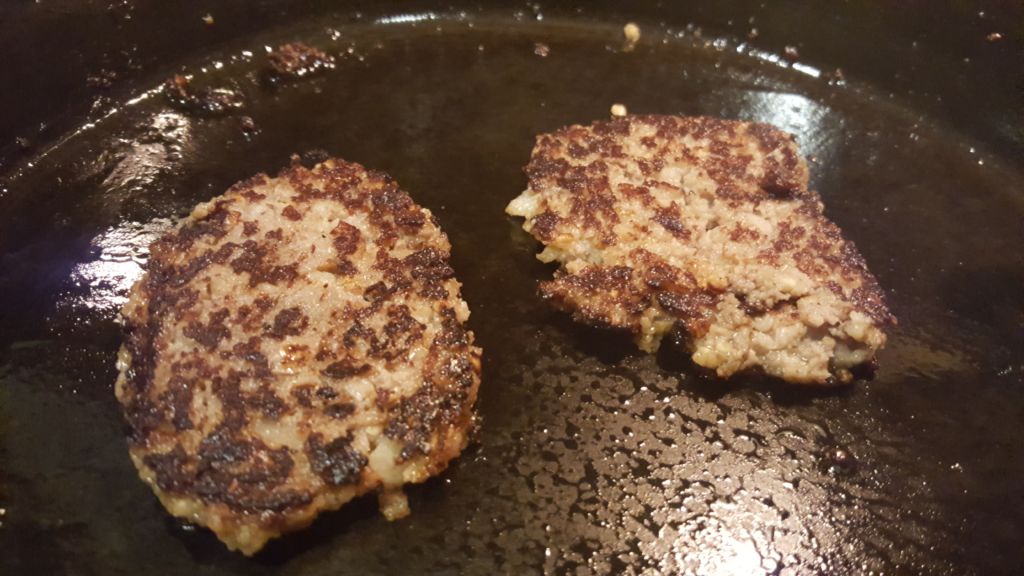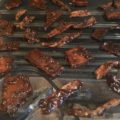I have all kinds of cast iron that I’ve been needing to clean and re-season. There are a few key pieces that sit on my stove top and I’ve decided that it was time to break out some additional pieces. Particularly, a nice saucepan with a lid and a double dutch oven (for lack of a better term). In all, there were two No. 8 skillets, a No 14 skillet (yeah, the big daddy) two waffle irons, two regular dutch ovens, the double dutch oven, an egg poacher, a cornbread pan, a muffin pan, and a star-shaped muffin pan.
I cook with cast iron daily… and rarely use anything else. Having your cookware properly seasoned and maintained only increases the performance of cast-iron. Here’s how I do it:
Seasoning your cast iron
- Clean your cookware real good. It’s OK to use a mild soap as you scrape off any junk. I used a wire brush and scouring pad to get it as clean as possible. A wire brush is good for rust (also a clue that your pan is not properly seasoned.)
- Dry everything off real good and then place it in the oven heated to 200F. We’re warming the cast iron up at this time…. completely drying it out and opening the pores per se.
- After 10 minutes or so, get your mitt and bring it out.
- Take about a teaspoon of 100%, flaxseed oil (organic, or the best you can find) and add to pan. Use a paper towel to distribute all over the pan, inside and out, getting the handle and everything. You can add more if you need, but know that you will be wiping it off as dry as possible before cooking. So, it doesn’t make sense to waste the oil since good flax seed oil is expensive.
- Once completely wiped down, put the pan back in the oven, inverted upside down and heat to 500F. Again, it’s important that the oil is wiped off real good and not dripping from the pan. Drippings can harden and create and uneven surface. As it cooks, we invert the pan to avoid pooling of the oil and allow slight dripping. So, you may want to catch them underneath.
- Once heated to 500F, set a timer for 1 hour. After an hour, turn off the oven and leave the pan to cool in the oven. This could take up to two hours. Remove the pan, and polish with a cloth.
- Repeat this process immediately… adding another teaspoon of oil, wiping off, and starting over. Repeat as many times as you have the energy for. The more times you do it, the better the season will be. It actually evens out the surface and makes a natural hard, non-stick surface. As you cook foods with grease and fats, it adds to the quality of the surface.
Notes worth mentioning
- In the past, I have tried all the oils, Crisco vegetable shortening, lard, and even bacon grease. Today, I use flax seed oil as there’s a lot of documented science behind fat polymerization. Think of flaxseed oil as the food-grade equivalent of linseed oil (the ‘drying oil’ that painters use to create a protective layer on their paintings).
- Not all flaxseed oil is created equal. Good flaxseed oil needs refrigeration and can go rancid quickly. Any that don’t need refrigeration means it has something added to it to hinder rancidity, and you don’t want that.
- If your cast iron comes out sticky, it could be the result of leaving too much oil on before you put it in the oven. Be sure to wipe it down dry. Don’t worry, there is oil left in the pores. This is a process that can’t be rushed, and iterative coats are required. Be sure also that your oven temperature is at 500F and bake for a full hour at that temperature.
- Flaxseed oil has one of the lowest smoke points at around 225F. When we heat oil above its smoke point, it releases its free radicals. This is not good during cooking, but really good for seasoning cast iron cookware. Open some windows and turn on the exhaust fans when you’re seasoning.
Cleaning your cast iron
Try not to soak your cast iron in water. Quite honestly, I’ll leave my pan with the grease from the morning’s bacon in it sitting on my stove until the next day. Then, I’ll scrape out the gunk with a metal spatula and reheat using the remaining oil residue. Otherwise, I clean mine right away while the pan is still warm. If I need some scouring action, I throw a little coarse kosher salt into the pan and wipe with a damp cloth to grind up the junk. Then rinse under the faucet.
When done washing, give a quick towel dry and then put it on your stove burner to completely dry it out. Don’t overcook the pan here! A minute or two should do it. Leave it on just long enough to dry it out. That next batch of sausage or bacon can lube it up again.





Leave a Reply